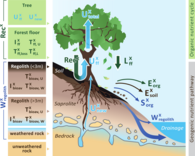Isotope geochemical determination of phosphorus weathering sources and fluxes in forest ecosystems | Phosflux
Primary productivity of forest ecosystems depends on the availability of plant‐essential mineral nutrients. However, temperate mountainous forest ecosystems experience permanent nutrient loss through i) plant litter erosion, ii) drainage of solutes sourced from mineral dissolution and plant litter solubilisation, and iii) rapid immobilization of plant growth limiting mineral nutrients such as phosphorus (P) and potassium (K) in the soil through occlusion and fixation, respectively.
In this Critical Zone project, we quantified deep (up to 20m depth) weathering and mineral nutrient cycling in two montane, temperate forest ecosystems located in Southern Germany (Black Forest, Bavarian Forest). We measured inventories, turnover times, and fluxes of macronutrients (K, Ca, Mg, P). We also fingerprinted the depth of nutrient uptake from the isotope ratios of 87Sr/86Sr and 10Be(meteoric)/ 9Be. We found evidence for a fast, shallow “organic nutrient cycle”, and a slow, deep “geogenic nutrient pathway”. Moreover, we found that the finite nutrient pool size of the forest floor persists for a few years only and that nutrient loss from the forest floor is balanced by nutrient uptake from the large pool of biologically available mineral nutrients in the several meters deep regolith. Finally, we found that the organic nutrient cycle apparently regulates the efficiency of nutrient re-utilization from organic matter (nutrient recycling) to cater for differences in its replenishment by the deep geogenic nutrient pathway, and thereby ensures long-term forest ecosystem nutrition.
Contact
- Dr. David Uhlig, Freie Universität Berlin
Time Frame
- 2013 - 2016
Funding
- DFG “Ecosystem Nutrition: Forest Strategies for limited Phosphorus Resources” (SPP 1685)
Publications
Uhlig, D., Sohrt, J., von Blanckenburg, F. 2024. Imbalances in dissolved elemental export fluxes disclose "hidden" Critical Zone compartments. Water Resources Research, 60, 6, e2023WR035517.
https://doi.org/10.1029/2023WR035517
Cai, D., Henehan, M. J., Uhlig, D., von Blanckenburg, F. 2024. Lithium isotopes in water and regolith in a deep weathering profile reveal imbalances in Critical Zone fluxes. Geochimica et Cosmochimica Acta, 369, 213-226. https://doi.org/10.1016/j.gca.2024.01.012
Cai, D., Henehan, M., Uhlig, D., von Blanckenburg, F. 2022. Mg isotope composition of runoff is buffered by the regolith exchangeable pool. Geochimica et Cosmochimica Acta, 321, 99-114, doi.org/10.1016/j.gca.2022.01.011
Uhlig, D., Amelung, W., von Blanckenburg, F. 2020. Mineral nutrients sourced in deep regolith sustain long‐term nutrition of mountainous temperate forest ecosystems. Global Biogeochemical Cycles, 34, 9, doi.org/10.1029/2019GB006513
Uhlig, D., Goldberg, T., Frick, D. A., von Blanckenburg, F. 2020. Quantifying beryllium concentrations in plant shoots from forest ecosystems using cation‐exchange chromatography and quadrupole ICP‐MS. Analytical Science Advances, 1, 1-14, doi.org/10.1002/ansa.202000036
Uhlig, D., & von Blanckenburg, F. 2019. How slow rock weathering balances nutrient loss during fast forest floor turnover in montane, temperate forest ecosystems. Frontiers in Earth Science, 7, 159, doi.org/10.3389/feart.2019.00159
Related data publications
Uhlig, D., Sohrt, J., von Blanckenburg, F. 2024. Major and trace element concentrations in Critical Zone water compartments in the Conventwald. GFZ Data Services. doi:10.5880/fidgeo.2023.020
Cai, D., Henehan, M., Uhlig, D., von Blanckenburg, F. 2022. Dataset on Biogeochemical cycling of Mg and Li isotopes in the Conventwald (the Black Forest, Germany). GFZ Data Services, doi.org/10.5880/GFZ.3.3.2021.005
Uhlig, D., Amelung, W., & von Blanckenburg, F. 2020. Chemical and isotope data on the deep regolith’s source of mineral nutrients in mountainous temperate forest ecosystems. GFZ Data Services, doi.org/10.5880/GFZ.3.3.2020.002
Uhlig, D., von Blanckenburg, F. 2019. Geochemical and isotope data on rock weathering, and nutrient balances during fast forest floor turnover in montane, temperate forest ecosystems. GFZ Data Services, doi.org/10.5880/GFZ.3.3.2019.004



